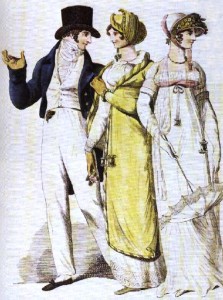Return to: Creative Visions > Jane Austen Grand Tour > Full Description
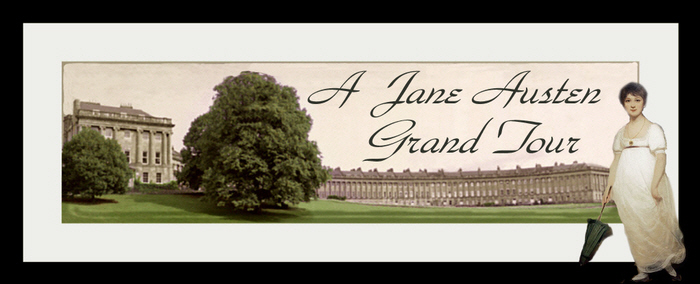
Jane Austen is one of the most revered and well-known English authors of the early 19th century and her 7 novels entitled “Emma”, “Pride and Prejudice”, “Persuasion”, “Sense and Sensibility”, “Susan”, “Nothanger Abbey” and “Mansfield Park” have remained exceptionally popular ever since. Austen’s novels are largely based upon the romance and social etiquette of the Regency period in which she lived but nevertheless still continue to provide a strong resonance in today’s modern world through her description of social courtship, love and marriage.
This tour is designed to appeal to those who are already very familiar with Jane Austen’s works as a writer, through reading her books or for those who may have only a general interest through watching one of the many television or film productions based on her work. The tour is over a 3 day period and promises to be first and foremost an experience of the places she was familiar during her lifetime as well as some of those we associate with her novels in film, whilst also providing a unique insight into the life of this great novelist. During our “Austen-tatious” tour we will also visit 3 of the most beautiful cities in England, 2 of it’s most impressive cathedral churches and one of it’s grandest country houses.
Our tour is three days and will start in Bath, finishing in Winchester for group A, and start in Winchester and finish in Bath for group B; both are exactly the same. This is for the convenience of our guests where pick up points in Bath or Winchester may be preferred. Please tell us which, if either, is more convenient for you.
“Austentatious” Bath
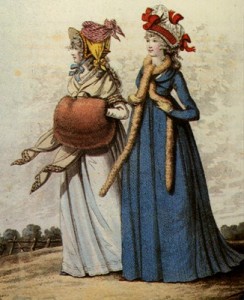 Bath experienced rapid development in the 18th century when it became a fashionable resort giving rise to a great number of Georgian buildings which today give the City its unique character of honey coloured limestone terraces. These terraces including the Royal Crescent, a crescent shaped residential terrace of 30 houses which were designed by the architect John Wood the Younger and are among the greatest examples of Georgian architecture to be found in England. After viewing the Royal Crescent we will visit the Jane Austen Centre at 40 Gay Street in Bath
Bath experienced rapid development in the 18th century when it became a fashionable resort giving rise to a great number of Georgian buildings which today give the City its unique character of honey coloured limestone terraces. These terraces including the Royal Crescent, a crescent shaped residential terrace of 30 houses which were designed by the architect John Wood the Younger and are among the greatest examples of Georgian architecture to be found in England. After viewing the Royal Crescent we will visit the Jane Austen Centre at 40 Gay Street in Bath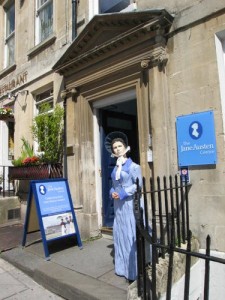 which houses a permanent exhibition telling the story of the novelist Jane Austen and the influence that living in Bath may have had upon the subject of her books. She paid two long visits to the City towards the end of the eighteenth century, and from 1801 to 1806 the novelist lived in Bath when her father obtained a clerical position. Austin’s intimate knowledge of Bath at a time when it was a fashionable meeting place for Georgian high society are reflected in two of her novels, “Northanger Abbey” and “Persuasion”, which are largely based upon the social circles that existed in Bath at that time. Despite the passing of many years, the townscape is still very much as Jane Austen would have known it and continues to attract visitors from all over the world. After a cream tea we will take you on a grand tour of many of the places associated with Jane Austen in Bath, followed by a sedate cruise on the River Avon which flows through the City. In the evening gather together for a evening meal in honour of Jane Austin, during which we will both reflect upon and celebrate her life.
which houses a permanent exhibition telling the story of the novelist Jane Austen and the influence that living in Bath may have had upon the subject of her books. She paid two long visits to the City towards the end of the eighteenth century, and from 1801 to 1806 the novelist lived in Bath when her father obtained a clerical position. Austin’s intimate knowledge of Bath at a time when it was a fashionable meeting place for Georgian high society are reflected in two of her novels, “Northanger Abbey” and “Persuasion”, which are largely based upon the social circles that existed in Bath at that time. Despite the passing of many years, the townscape is still very much as Jane Austen would have known it and continues to attract visitors from all over the world. After a cream tea we will take you on a grand tour of many of the places associated with Jane Austen in Bath, followed by a sedate cruise on the River Avon which flows through the City. In the evening gather together for a evening meal in honour of Jane Austin, during which we will both reflect upon and celebrate her life.
“Austentatious” Salisbury
The Cotswold village of Lacock situated near the town of Chippenham is probably one of the 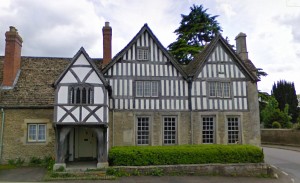 most filmed villages in England. This pretty picture postcard village in the county of Wiltshire, dates from the 13th century and its many stone, thatched and half timbered buildings have provided a perfect backdrop for TV and film productions of novels, such as “Pride and Prejudice” (1967,1995 and 2005), “Emma” (1996) “Moll Flanders”(1996) and “The Mayor of Casterbridge” (2003) and “Harry Potter”. Most of the buildings in the village are owned by the National Trust, who have carefully preserved the character of the Village making it own of the best preserved 18th century villages in the Country and a must for any Austen fan. After a walk around the village and a traditional English cream tea we will visit the Laycock Abbey an Augustinian nunnery founded 1229.
most filmed villages in England. This pretty picture postcard village in the county of Wiltshire, dates from the 13th century and its many stone, thatched and half timbered buildings have provided a perfect backdrop for TV and film productions of novels, such as “Pride and Prejudice” (1967,1995 and 2005), “Emma” (1996) “Moll Flanders”(1996) and “The Mayor of Casterbridge” (2003) and “Harry Potter”. Most of the buildings in the village are owned by the National Trust, who have carefully preserved the character of the Village making it own of the best preserved 18th century villages in the Country and a must for any Austen fan. After a walk around the village and a traditional English cream tea we will visit the Laycock Abbey an Augustinian nunnery founded 1229.
 Like the village itself, this 13th century Abbey at Lacock is also exceptionally well preserved and contains it’s original medieval cloisters, chapter house, sacristy and monastic rooms. During the 16th century the abbey was converted to a country house with the addition of a stable courtyard with clockhouse and contains many portraits, fine furniture and stone carvings. The carvings are of particularly high standard by John Chapman, a stonemason to Henry VIII. In Victorian times an extensive woodland garden was developed and now boasts a fabulous display all year round. A former resident of the Abbey is William Henry Fox Talbot (1800-1877) is credited with inventing the positive/negative photographic process. No doubt Fox Talbot would have been very delighted to know that Lacock has been so strongly associated with photography and film in recent years including the Abbey itself which has been used on a number of occasions for the Harry Potter series of films in which it appears as Hogwarts School.
Like the village itself, this 13th century Abbey at Lacock is also exceptionally well preserved and contains it’s original medieval cloisters, chapter house, sacristy and monastic rooms. During the 16th century the abbey was converted to a country house with the addition of a stable courtyard with clockhouse and contains many portraits, fine furniture and stone carvings. The carvings are of particularly high standard by John Chapman, a stonemason to Henry VIII. In Victorian times an extensive woodland garden was developed and now boasts a fabulous display all year round. A former resident of the Abbey is William Henry Fox Talbot (1800-1877) is credited with inventing the positive/negative photographic process. No doubt Fox Talbot would have been very delighted to know that Lacock has been so strongly associated with photography and film in recent years including the Abbey itself which has been used on a number of occasions for the Harry Potter series of films in which it appears as Hogwarts School.
During that day we will visit the cathedral city of Salisbury. This small English 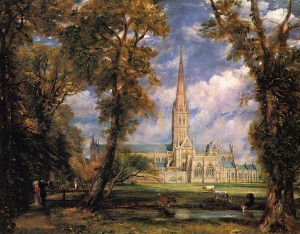 town contains a wealth of historic Medieval and Georgian buildings but is most notable for its magnificent Gothic cathedral which towers over the town and the surrounding countryside. Unlike many other cathedrals in Britain Salisbury was constructed within a relatively short time period of less than 40 years between 1220 and 1258 AD whilst its spire is the tallest in England and for centuries made the cathedral the tallest structure in the country. Even for those that have never visited Salisbury the cathedral should be recognizable from the famous painting in the 19th century by John Constable as well as William Golding’s book “The Spire” which is based on the story of the construction of Salisbury Cathedral and portraying the height of the spire as one man’s obsessive quest.
town contains a wealth of historic Medieval and Georgian buildings but is most notable for its magnificent Gothic cathedral which towers over the town and the surrounding countryside. Unlike many other cathedrals in Britain Salisbury was constructed within a relatively short time period of less than 40 years between 1220 and 1258 AD whilst its spire is the tallest in England and for centuries made the cathedral the tallest structure in the country. Even for those that have never visited Salisbury the cathedral should be recognizable from the famous painting in the 19th century by John Constable as well as William Golding’s book “The Spire” which is based on the story of the construction of Salisbury Cathedral and portraying the height of the spire as one man’s obsessive quest.
After a visit to the Cathedral in Salisbury we take a tour of Mompesson House in the Cathedral Square, an elegant and spacious 18th century house built for the local Member of Parliament Charles Mompesson in 1701 and featured extensively in the film “Sense and Sensibility”. The property has been restored to its original early eighteenth century appearance, with ornate plasterwork, fine period furniture and graceful oak staircase,. The house also includes a large display of 18th century drinking glasses.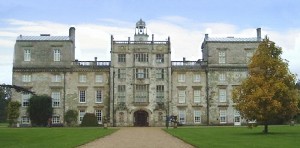
Whilst in Salisbury we will visit nearby Wilton House the stately home of the Earls of Pembroke. This magnificent country house dates from the 17th century and contains some truly magnificent interiors including the the Double Cube room  which houses the world famous collection of Van Dyck paintings. This room, among many others at Wilton has provided film-makers the perfect setting for films such as, “Sense and Sensibility”, “Mrs. Brown”, “Pride and Prejudice” and most recently the film “The Young Victoria”.
which houses the world famous collection of Van Dyck paintings. This room, among many others at Wilton has provided film-makers the perfect setting for films such as, “Sense and Sensibility”, “Mrs. Brown”, “Pride and Prejudice” and most recently the film “The Young Victoria”.
“Austentious” Winchester
We travel to the village of Steventon where Jane Austen spent the first 25 years of her life and where her father was rector. The rectory is now demolished but we will pay a visit to the 13th century St Nicholas Church, where the Austen family had served as rectors from 1759 to 1873. Jane’s very full social life at Steventon provided her with much of the material for her novels, and most of her life-long friendships were made during her time there. It was whilst living in the village, she wrote “Northanger Abbey”, “Sense & Sensibility” and “Pride & Prejudice”, although there were not published at that time. Her father offered Pride & Prejudice to a publisher in 1797 who turned it down without reading it. Whilst visiting the village we will walk along Popham Lane, along which Jane must have walked to pick up letters at the Wheatsheaf Inn in the village which was then a stop for the mail coach.
In addition to her childhood home at Steventon we visit the Hampshire village Chawton where Jane Austen 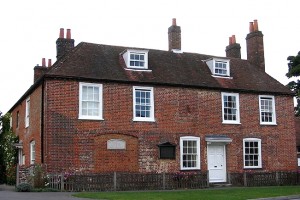 spent the last years of her life. Chawton was the site of an ancient settlement dating back to the New Stone Age period and the Domesday Book of 1086 records that the manor comprised ploughed and wooded land belonging to a Saxon Thane called Oda, during the time of Edward the Confessor. Following the Norman Conquest, William the Conqueror made Oda surrender Chawton to his Norman follower Hugh de Port.
spent the last years of her life. Chawton was the site of an ancient settlement dating back to the New Stone Age period and the Domesday Book of 1086 records that the manor comprised ploughed and wooded land belonging to a Saxon Thane called Oda, during the time of Edward the Confessor. Following the Norman Conquest, William the Conqueror made Oda surrender Chawton to his Norman follower Hugh de Port. 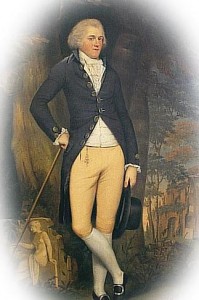 De Port and his descendants held Chawton in direct male line for nearly three hundred years. Thereafter it was held in the female line until the middle of the sixteenth century. In 1781, Thomas Knight II inherited the Chawton estate which includes the village, but when he and his wife Catherine showed no sign of having children of their own, they adopted a son of the Reverend George Austen (Jane’s father), who was a cousin of Thomas Knight’s. The Austens had six sons and two daughters, and the Knights adopted the third eldest son, Edward. Edward Austen Knight who eventually took over management of the estates at Godmersham and Chawton in 1797, living mostly at Godmersham and letting the Great House at Chawton to gentlemen tenants. In 1809 he offered a house in the village to his mother and two sisters Cassandra and Jane Austen who had become severe financial difficulties owing to the death of their father.
De Port and his descendants held Chawton in direct male line for nearly three hundred years. Thereafter it was held in the female line until the middle of the sixteenth century. In 1781, Thomas Knight II inherited the Chawton estate which includes the village, but when he and his wife Catherine showed no sign of having children of their own, they adopted a son of the Reverend George Austen (Jane’s father), who was a cousin of Thomas Knight’s. The Austens had six sons and two daughters, and the Knights adopted the third eldest son, Edward. Edward Austen Knight who eventually took over management of the estates at Godmersham and Chawton in 1797, living mostly at Godmersham and letting the Great House at Chawton to gentlemen tenants. In 1809 he offered a house in the village to his mother and two sisters Cassandra and Jane Austen who had become severe financial difficulties owing to the death of their father.
It was whilst living at Chawton that Jane Austen began the most prolific period 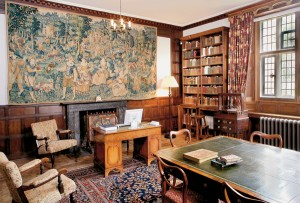 of her writing life and the happiest. Her sister Cassandra took on much of the domestic duties allowing Jane to write. The manuscripts she had worked on in the 1790′s were brought out again to be revised the first of which was “Sense and Sensibility”. Her brother Henry was instrumental in getting it published and helping to pay an advance on the printing costs. She went on to publish a further three of her novels while at Chawton (two more followed shortly after her death). She lived in Chawton almost until her death in 1817, only moving to Winchester near the end of her life to be nearer medical care. Jane Austen’s house is now a museum dedicated to the author. There is an extensive collection of family mementos and documentary material, including copies of letters written by her. A pretty garden surrounds the house, stocked with many old varieties of flowers and herbs and Jane’s donkey carriage is displayed in the adjoining old bakehouse.
of her writing life and the happiest. Her sister Cassandra took on much of the domestic duties allowing Jane to write. The manuscripts she had worked on in the 1790′s were brought out again to be revised the first of which was “Sense and Sensibility”. Her brother Henry was instrumental in getting it published and helping to pay an advance on the printing costs. She went on to publish a further three of her novels while at Chawton (two more followed shortly after her death). She lived in Chawton almost until her death in 1817, only moving to Winchester near the end of her life to be nearer medical care. Jane Austen’s house is now a museum dedicated to the author. There is an extensive collection of family mementos and documentary material, including copies of letters written by her. A pretty garden surrounds the house, stocked with many old varieties of flowers and herbs and Jane’s donkey carriage is displayed in the adjoining old bakehouse.
During the day we will also visit nearby cathedral city of Winchester which is the county town of Hampshire. The City is famous for its distinctive cathedral which is one of the largest in England and has the longest nave and overall length of any Gothic cathedral in Europe. The Cathedral has its origins in the 7th century when a Christian Church was first built on this site. This Saxon church subsequently grew to become a Benedictine monastery named the Priory of St. Swithun when the town became the centre of Wessex and, subsequently the whole of the Anglo-Saxon kingdom..The present church, the longest Medieval cathedral in Britain, dates from 1079, and was built in the Norman (Romanesque) style. St. Swithun’s remains were moved to the new church in 1093.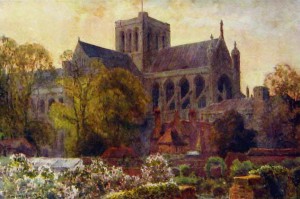
The cathedral was at the heart of a powerful diocese that stretched from the Thames River to the Channel Islands and attracted many pilgrims who came to pray at the tombs of Swithun and other saints.The influential and wealthy bishops of Winchester further developed and adorned their cathedral throughout the Middle Ages.The cathedral’s library contains over 4,000 books, including several illuminated manuscripts from the Middle Ages. Especially notable are Bishop Morley’s 17th-century book collection and an exhibition room contains the 12th-century Winchester Bible. The Winchester Bible is the finest of the great 12th century illuminated bibles, distinguished by its sheer size and sumptuous decoration. Using over 250 skins of calves, illuminators working over a period of 15 years depicted words and scenes from the Bible in pure gold and lapis lazuli from Afghanistan. The Triforium shows sculpture, woodwork, and metalwork from 11 centuries and provides magnificent views over the rest of the cathedral.
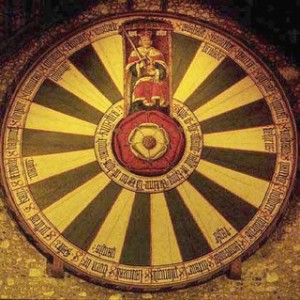 Situated at the top of the High Street just to the left of The Westgate are the Great Hall and Sally Port which are are the only surviving parts of Winchester Castle. The Great Hall was one of the largest and finest in England, and is certainly the finest of that period to have survived today. Its many features include stained-glass windows, a judges’ gallery and wrought steel gates that were installed in 1983 to commemorate the wedding of the Prince of Wales and Lady Diana Spencer. On the wall of the Great Hall you can see the Round Table. This was made in about 1250. According to ancient legends, King Arthur sat around a round table like this with his 24 knights. In 1520 King Henry the Eighth had this table painted. Each of the 24 segments represents one of Arthur’s knights. In the centre Henry put a rose, the symbol of his family (the Tudors), and above this is a picture of King Arthur, based on his own likeness.
Situated at the top of the High Street just to the left of The Westgate are the Great Hall and Sally Port which are are the only surviving parts of Winchester Castle. The Great Hall was one of the largest and finest in England, and is certainly the finest of that period to have survived today. Its many features include stained-glass windows, a judges’ gallery and wrought steel gates that were installed in 1983 to commemorate the wedding of the Prince of Wales and Lady Diana Spencer. On the wall of the Great Hall you can see the Round Table. This was made in about 1250. According to ancient legends, King Arthur sat around a round table like this with his 24 knights. In 1520 King Henry the Eighth had this table painted. Each of the 24 segments represents one of Arthur’s knights. In the centre Henry put a rose, the symbol of his family (the Tudors), and above this is a picture of King Arthur, based on his own likeness.
Jane Austen died in Winchester on 18 July 1817. Through his clerical connections, 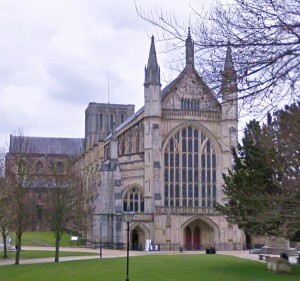 Henry arranged for his sister to be buried in the north aisle of the nave of Winchester Cathedral. The epitaph composed by her brother James praises Austen’s personal qualities, expresses hope for her salvation, mentions the “extraordinary endowments of her mind”, but does not explicitly mention her achievements as a writer. Her gravestone can be seen on the flooring of the north side of the nave whilst a new exhibition at the Cathedral features a mix of permanent and rolling exhibits borrowed from a number of rare collections around the world, including the authors burial register and first editions and original fragments of her writing. It is interesting to note that the original Abbey which became Winchester Cathedral shared the same name of Saint Swithin’s than the small church in Bath that her father and mother were married and where her father the Reverend George Austen was laid to rest.
Henry arranged for his sister to be buried in the north aisle of the nave of Winchester Cathedral. The epitaph composed by her brother James praises Austen’s personal qualities, expresses hope for her salvation, mentions the “extraordinary endowments of her mind”, but does not explicitly mention her achievements as a writer. Her gravestone can be seen on the flooring of the north side of the nave whilst a new exhibition at the Cathedral features a mix of permanent and rolling exhibits borrowed from a number of rare collections around the world, including the authors burial register and first editions and original fragments of her writing. It is interesting to note that the original Abbey which became Winchester Cathedral shared the same name of Saint Swithin’s than the small church in Bath that her father and mother were married and where her father the Reverend George Austen was laid to rest.
Although not available for public viewing we will finally look at the house where Jane Austen spent the last six weeks of her life. Situated close to the entrance to Winchester College and marked with a blue plaque above the entrance door, Jane was writing her novel “Persuasion” at the time she was living here, which sadly wasn’t published until after her death. Located in the north nave aisle of Winchester Cathedral Jane Austen’s tomb is marked by a brass plaque which reads:
JANE AUSTEN
Known to many by her writings, endeared to her family by the varied charms of her characters and ennobled by her Christian faith and piety
was born at Steventon in the County of Hants, December 16 1775 and buried in the Cathedral July 18 1817.
“She openeth her mouth with wisdom and in her tongue is the law of kindness.”
Our tour will then conclude and return to the hotel for a formal evening meal and wine to toast the memory of the great authoress. Those that are interested may like to attend an Evensong service before dinner at the Cathedral, starting at 5.30pm ,to make their own very personal dedication and thanks to the popular novelist who’s creative writing we adore so very much.
A special Austen Weekend in September!
As part of the Jane Austen Festival we invite our guests to come and join a grand costume parade in Bath.
Promenade walks in the 18th and 19th centuries, were leisurely walks in public and usually undertaken in the local park on Sunday afternoons after attending church. Whole families would dress in their finest clothes and walk together whilst engaged in casual conversation. These promenade walks enabled social mixing and interaction and more than occasionally the opportunity of some flirtation, whilst providing what we call “Quality Time Together” a regular weekly occasion. Every year the beginning of Bath’s Jane Austen Festival in September is begun by an organised promenade in which Austen enthusiasts dress up in period costume and recreate these gentile strolls which formed a considerable part of Regency social life, in honour of the author. Other events include readings, tours of her former home and the places that inspired her literature.
Old School Tours extend a cordial invitation to come along with us and create some quality time of your own by participating in this magnificent cavalcade of Regency costume which will be the main highlight of our Austen Tour in September. Bring your own or we can assist you in finding a suitable costume and organise suitable changing facilities, enabling you to come along in the afternoon on a tour of the many places in Bath associated with Jane Austen. Your tour guides will be dressed for the event and will ensure that you will feel truly part of this very special occasion which the event organisers anticipate will reach a new record number of those attending in Regency dress. The parade will finish at The Royal Crescent which is Bath’s most notable Georgian terrace for refreshments and photographic opportunities. The Jane Austen Promenade promises to be exceptional fun and we urge our all tour guests to come along and participate to honour the autheress but should you not wish to take an active part we promise not to let you feel left out and hope you will come to help preserve the day in pictures and video. After a cream tea we will take you on a grand tour of many of the places associated with Jane Austen in Bath, followed by a sedate cruise on the River Avon which flows through the City. In the evening both tour groups A and B will join together for a evening meal in honour of Jane Austin at which we will both reflect upon and celebrate her life. Tour dates for this very special Austen tour are from 13th-16th or 16th-19th September.
Jane Austen Tour Highlights:
Historic Bath
- Bath – Beautiful city in England’s west country, filled with Georgian architecture and some Roman remains.
- Grand Costumed Promenade – A strolling parade of Jane Austen lovers dressed in the Georgian period costume which you take part in.
- The Royal Crescent – Beautiful Georgian terrace that forms a crescent shape.
- Cream Tea in Bath - We’ll enjoy a traditional cream tea together in Bath.
- Cruise on the River Avon - a relaxing boat cruise on the River Avon which flows through Bath.
- Evening meal in honour of Jane Austen
Historic Salisbury
- Village of Lacock - 13th C. Town used in many familiar films.
- Cream Tea in Lacock - we’ll enjoy a traditional cream tea in this quaint village.
- Lacock Abby – An Augustinian Abby founded in 1229 that holds stone carvings done for Kind Henry VIII, fine furniture, gardens, cloisters and so much more.
- City of Salisbury – Medieval town most noted for the Gothic Cathedral.
- Salisbury Cathedral – completed in 1258 AD and for centuries was the tallest structure in England.
- Mompesson House – Featured extensively in the film “Sense and Sensibility”.
- Wilton House – contains a famous collection of Van Dyke paintings, many Austen films and others were filmed here.
Historic Winchester
- Village of Steventon – Where Jane Austen spent the first 25 years of her life and she wrote Northanger Abbey, Sense & Sensibility and Pride & Prejudice.
- St. Nicholas Church – Where the Austen family served as rectors.
- Village of Chawton – Site of an ancient stone age settlement and where Jane spent the last years of her life; it was the most prolific writing time in her life.
- Jane Austen’s House – Now a museum with letters written by her, mementos, flower garden with old varieties and her original donkey cart.
- City of Winchester -
- Winchester Cathedral – 7th C cathedral with the longest nave and overall length of any Gothic cathedral in Europe, it’s library contains over 4,000 books. It’s the burial place of Miss Austen.
- Great Hall of Winchester Castle - Which has the Round Table thought to have been used by King Arthur and his knights.
- The last house Miss Austen lived in – where she worked on the novel “Persuasion”.
- Formal evening meal – We’ll end our tour with a dinner and toast to Jane Austen.
- Evensong – An evening service held at Winchester Cathedral for Jane Austen.
At Old School Tours we don’t believe in advertising what seems a ‘low price’ but doesn’t include many things we believe to be standard, such as entrance fees, dinners, breakfasts and quality hotels and B+B’s. Each day’s detail page shows the highlights of where we’ll be going and below you can find the price and what it includes. We look forward to having you on our adventure and guarantee a quality touring experience!
This full 3 Day luxury touring holiday is only £ * and includes:
- 3 Full English Breakfasts.
- 3 Hot dinners either at a fine pub, Hotel or Restaurant.
- 3 Nights accommodations at hotels
- Entrance fees each day to listed attractions we visit.
- Full 3 days fare on air conditioned/heated luxury coach.
- Two personal, educated tour guides filled with enthusiasm and good spirit, ready to make sure you are taken care of and have a good time!
What it doesn’t include:
- Lunches
- Alcoholic beverages
- Personal spending, shopping, tipping
- Fares before and after the tour, to get you to and from home.
*Go here to convert tour costs to your currency: XE The World’s Favorite Currency Converter Site
*Prices are at the time of publication and may vary slightly, just contact us to inquire!
*Prices are based on two people sharing (single rooms available at a supplement)
For more information see: “Making a Reservation” and “Terms and Conditions”.




